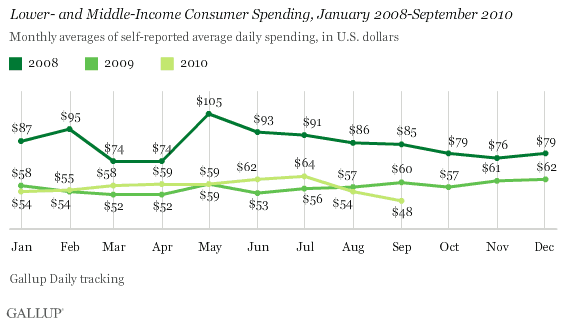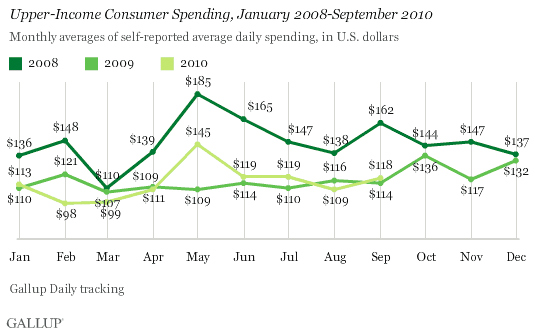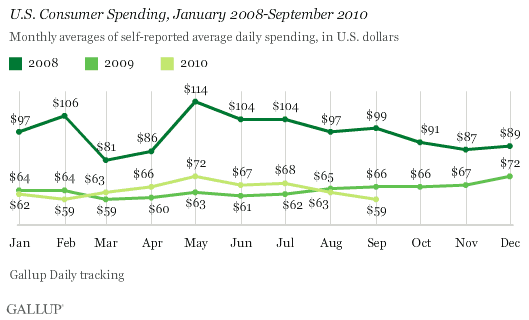PRINCETON, NJ -- Lower- and middle-income Americans' self-reported average daily spending in stores, restaurants, gas stations, and online averaged $48 per day during September -- down $6 from August and $16 from July. Consumer discretionary spending by these Americans making less than $90,000 a year is now at its lowest level since Gallup began daily tracking in January 2008, as the recession was just getting underway.

Upper-Income Spending Remains Essentially Flat
Upper-income Americans reported spending an average of $118 per day in September -- up $9 from August but virtually the same as they spent in June and July. Spending among this group making $90,000 or more annually is not much different from the $114 they spent in September 2009. Only once -- in May -- has 2010 upper-income spending exceeded the 2009 "new normal" upper-income spending range of $107 to $121 per day.

Overall Spending Ties Previous Lows
Overall, Americans' spending averaged $59 per day during September -- down from $63 in August and $68 in July, and lower than the $66 of September 2009. Americans' spending has generally been running slightly higher in 2010 than it did in 2009 -- though substantially below the recessionary spending levels of 2008. September spending matches the previous lows of February 2010 and March 2009.

Spending Trends Could Mean Double-Dip
The decline in lower- and middle-income Americans' spending to new lows over the past two months may be a precursor of another significant drop in the overall economy. Gallup's self-reported spending data tend to measure consumers' discretionary or marginal expenditures, making these measures highly sensitive to shifting consumer spending patterns.
Gallup modeling suggests that lower- and middle-income spending is significantly more sensitive to job market conditions than is upper-income spending. In this regard, the September decline in lower- and middle-income spending may reflect the sharp increase in unemployment over the same period and continued high underemployment levels. Further, the lagged effects of continuing high and increasing unemployment are probably yet to be fully felt.
On the other hand, upper-income spending tends to be more responsive to the "wealth effects" associated with higher stock and commodities prices. Although upper-income spending hasn't been increasing in response to the best September on Wall Street in 71 years -- at least to this point -- upper-income Americans have maintained their spending, while that of other Americans has declined.
Given this context, the recent Federal Reserve discussions about another round of quantitative easing seem to make a lot of sense. The Fed needs to do everything it can to keep the U.S. economy from experiencing another decline in economic activity -- a so-called double-dip. While it is not clear that this Fed effort will help the overall economy in the immediate term, anticipation of it has Wall Street surging and the dollar plummeting. In theory, the resulting wealth gains could have the beneficial effect of increasing upper-income spending.
Regardless, Gallup's September spending and jobs data suggest that the possibility of a double-dip is no longer negligible. Congress needs to show the same sense of urgency as the Fed concerning what it can do for jobs and the economy when it convenes in its planned lame-duck session after the midterm elections.
Gallup.com reports results from these indexes in daily, weekly, and monthly averages and in Gallup.com stories. Complete trend data are always available to view and export in the following charts:
Daily: Employment, Economic Confidence and Job Creation, Consumer Spending
Weekly: Employment, Economic Confidence, Job Creation, Consumer Spending
Read more about Gallup's economic measures.
Survey Methods
Results are based on telephone interviews conducted as part of Gallup Daily tracking Sept. 1-30, 2010, with a random sample of 15,048 adults, aged 18 and older, living in all 50 U.S. states and the District of Columbia, selected using random-digit-dial sampling.
For results based on the total sample of national adults, one can say with 95% confidence that the maximum margin of sampling error is ±1 percentage point.
Interviews are conducted with respondents on landline telephones and cellular phones, with interviews conducted in Spanish for respondents who are primarily Spanish-speaking. Each daily sample includes a minimum quota of 150 cell phone respondents and 850 landline respondents, with additional minimum quotas among landline respondents for gender within region. Landline respondents are chosen at random within each household on the basis of which member had the most recent birthday.
Samples are weighted by gender, age, race, Hispanic ethnicity, education, region, adults in the household, cell phone-only status, cell phone-mostly status, and phone lines. Demographic weighting targets are based on the March 2009 Current Population Survey figures for the aged 18 and older non-institutionalized population living in U.S. telephone households. All reported margins of sampling error include the computed design effects for weighting and sample design.
In addition to sampling error, question wording and practical difficulties in conducting surveys can introduce error or bias into the findings of public opinion polls.
For more details on Gallup's polling methodology, visit www.gallup.com.
